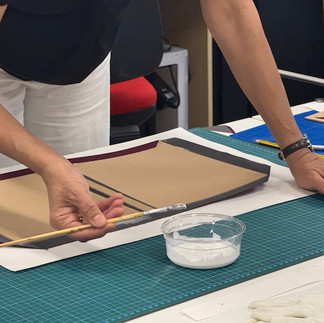Teaching bookmaking
- siladan010
- May 26
- 2 min read
As part of the theory module this year, I was asked to guide our students through the process of making books, not only as an academic exercise, but also so their final pieces could be shown at their graduation show in June.
Throughout the year, I worked closely with my students, teaching them how to think through the structure of a book how to sequence images and text meaningfully, how to work with InDesign to bring those ideas into form, how to approach printing in relation to layout and signatures, how to bind their pages through stitching, and most recently, how to construct a cover that holds it all together.
The process wasn’t a one-way transmission of knowledge. I see my work with students as a shared experience. I bring what I know and try to offer it clearly and generously, but I also remain open to their questions, their instincts, and the knowledge they already carry. I see teaching not as delivering fixed answers, but as cultivating an exchange one where both sides remain attentive to the possibilities of the work, and of each other.
Below are a few photographs from the sessions. They capture not just the making, but something of the atmosphere the quiet focus, the collaborative energy, and the mutual learning that shaped our time together.
Learning Through Teaching
This year, supporting students through the process of book-making and other workshops and lecturers that I was part of opened up critical questions not only about pedagogy but about my own practice. Teaching a collaborative, materially grounded process within an institutional framework required me to consider the shifting roles of authorship, control, and resolution.
In the above context, while in reflection, it was inevitable for this question to follow:
How has teaching book-making as a collaborative process challenged and expanded my understanding of form, authorship, and control within my own artistic practice?
The question arose after my student repeted fe time: "Thank you Daniel, this is a collaborative work now"
But how about the reverse question? As educators, we develop concepts and ideas for form based on the responses we receive from our students? How do we transfer this process into a collaborative?
This will challenge me with the more solitary aspects of my practice, encouraging a renewed attention to how meaning can emerge collectively, and not just individualy.
My own work often resists closure: chemigrams, lumen prints, and etchings all carry within them a sense of process, flux, and impermanence. The books I made as defined structures became a place where those ideas were tested.
Teaching with this in mind made me more critically aware of where my work is willing to expand and move.












